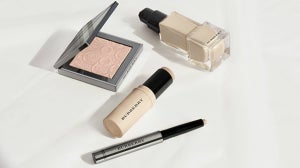Here to answer all new mum’s breastfeeding dilemmas,we call on Victoria Holyoak, midwife at Mama Mio, to help resolve your latching concerns, PLUSexpert tips and tricks on how to make your breastfeeding experience as comfortable as possible for you and your little one!

The LOOKFANTASTIC Pregnancy Report - How to look after your skin when you’re expecting
LOOKFANTASTIC has released a report that delves into the most common pregnancy based skincare concerns, what to avoid when you're expecting and the biggest pregnancy beauty trends.
What signs can I look for to know my baby is getting enough milk?
At the early stages of breastfeeding, many may struggle to recognise whether their baby is getting good milk transfer. Midwife Vic agrees: “This is definitely one of the most asked questions for new mums, and it causes such anxiety!”
“My first tip to knowing whether your little one is ‘getting enough’ is looking at the nappies. Your baby should be having regular dirty nappies every day with a gradual change in the colour within the first 5 days or so – moving from black to green to then a latterly yellow.”
“During this, if you baby is receiving good milk transfer, their weight should increase over time too.”
Can you increase your milk supply after pregnancy?
Most find that increasing milk production comes naturally after pregnancy. Victoria says “Milk supply works on a supply and demand mechanism. The more that comes out, the more that comes in.”
However, if you still feel like you're not producing enough milk, there are alternative options to stimulate your supply. Victoria advises on incorporating breastfeeding practices such as “additional pumping sessions and hand expressing.”
Hand expressing is the action of massaging milk of your breasts, conducted by lightly pressing your thumb and forefinger towards each over in a rolling action. To make this process easier, use a body oil to encourage a smoother massage whilst keeping your skin nourished.
Before introducing any new methods or products into your routine, it's always advised to speak to your midwife for advice and support.
Why might my baby be struggling to latch?
As you begin your journey as a new mum, it is important to remember that both you and your baby are beginners to this. Taking the time to learn with your baby on how to latch will make these skills much easier in practice.
Victoria says: “Getting support from your midwife and specialist feeding practioners will really help hone the latch too, especially for women struggling with discomfort whilst trying. This can leas to issues with longue tie, supply, let down or positioning.”
What are the best ways to encourage my baby to latch?
As you learn to breastfeed, motivating your baby to latch more often can encourage a strong routine. This should start with assuring your baby is ready to feed, Victoria advises “make sure your little one is awake and ready, placing them tummy to tummy so you’re both comfortable.”
Once you are relaxed and in your preffered positioning, try following these steps to encourage a latch:
“Making sure their head, neck and body are aligned, place your nipple at the bridge of their nose. Your aiming for your little one to go onto the breast with their head angled upwards.”
If you’re experiencing any pain during this time have the confidence to stop the feed. ”Reposition for a better latch, because your baby's head may not be angled upwards enough.”
How do I know when my baby is properly latched?
Signs of a good latch can be seen in the subtle positioning or behaviour that your baby displays. Victoria advises to look out for suckiling patterns:
“If your baby is latched well, they will get into a consistent suckling pattern. The pauses between each episode of sucking should be long, but this is normal. However if your baby falls asleep quickly at the breast, or continues to suck consistently with no breaks, they’re likely not quite correctly latched.”
If you’re noticing your baby isn’t latched, its best to start again and try repositioning. Making sure you and your baby are comfortable.
Is it normal to experience latching pain, If so are there any ways to combat this?
It is advised not to feed through the pain incase you cause damage to your breast or nipple. If you are experiencing pain, make sure to call your midwife – they can help contribute towards making this time easier for you and your little one!
Taking this into consideration, Victoria reveals - “It is normal to experience discomfort when your baby first latches, but this usually only takes a few seconds while your baby establishes the feed.
If you are feeling soreness or dryness in the nipples from feeding, a nipple cream can help lock in moisture and protect the skin to make this time easier for you. Our favourites?
How often should I breastfeed my baby?
Advice on breastfeeding can vary for every baby, and what works for one may not work for the other. Victoria advises ‘babies should feed 8-12 times over a 24 hour period”, however some may struggle to stick to this ridged pattern and routine. But no need to worry, this is normal in many little ones - “As long as they are feeding regularly, passing urine and stool regularly and gaining weight, this is okay.”
Do I have to breastfeed If I don’t want to?
If you’re feeling unsure about breastfeeding, rest reassured that this is completely normal, this decision should always be between you and what feels right for your body. Midwife Vic stating “How you wish to feed your baby is an incredibly personal decision and there are a number of factors that need to be considered.”
Shop more pregnancy products on LOOKFANTASTIC!








